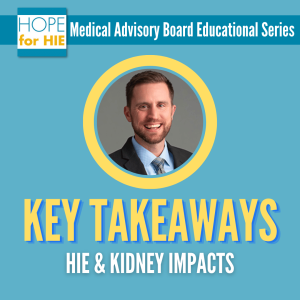
When you think about the different impacts of HIE, your mind may jump to more well-known conditions like epilepsy or cerebral palsy. But here’s something you might not have heard: around 30 to 50 percent of newborns with moderate to severe HIE might also experience Acute Kidney Injury (AKI) in their early days. And for some of them, there’s a chance of developing Chronic Kidney Disease later in life.
Dr. Matthew Harer, a neonatologist at UW Health in Wisconsin, wants us to remember that HIE can affect more than just the brain—it can impact other organs, too, including the kidneys. Recognizing the signs and symptoms and managing potential complications like kidney issues can improve the quality of care and long-term outcomes for babies and children impacted by HIE.
Missed our live Q&A? No worries. We took notes, and like any good partner, we are willing to share! Read our key takeaways below.

Just like how limited blood flow and oxygen to the brain can lead to injury, the same goes for the kidneys. When there’s restricted blood flow and oxygen, it often results in a type of injury known as Acute Tubular Necrosis, or ATN. This condition damages the tiny filtering units (tubules) in the kidneys, causing problems with filtering waste from the blood.
Interestingly, there’s already a reduced blood flow to the kidneys at birth. Initially, the kidneys only receive about 4% of the heart’s output in the hours following birth, though this increases to around 10% within the first few days. So, any additional disruption to this delicate balance can cause injury and loss of function, leading to difficulties in effectively filtering the blood and maintaining normal electrolyte and fluid levels.

The exact mechanisms of how blood flow redistributes throughout the body during a severe brain injury are not fully understood, so it’s important to note that severe brain injury does not always mean severe kidney injury. Still, more often than not, this is the case: while babies who have mild HIE typically do not have AKI, those with moderate or severe HIE do have higher rates of injury.
Similar to HIE’s grading system, AKI is categorized on a scale. Each stage indicates the severity of kidney injury, with Stage 1 being the least severe and Stage 3 being the most severe. This staging system helps healthcare professionals to assess and manage acute kidney injury based on its severity.

Transient kidney issues imply that the injury or associated concerns are short-term and expected to resolve on their own or with appropriate treatment.
The most common transient issues in the first three days of life include:
When in the NICU and even during therapeutic hypothermia—if that is an intervention your hospital provides—Dr. Harer recommends that medical professionals check these outputs and levels every six hours to plan and treat accordingly.
There’s definitely a gap in our understanding when it comes to the long-term kidney health of children who’ve had HIE as infants. Doctors are still trying to figure out how these babies fare in terms of kidney function as they grow up. While we don’t have all the answers yet, there’s a concern that babies with HIE and AKI might be at a higher risk of developing Chronic Kidney Disease (CKD) later on.
We know this because of broader studies done on both kids and adults who’ve had kidney injuries. These studies followed people over a long period and found that those who experienced kidney injury were more likely to develop CKD compared to those without such injuries.
Based on the limited number of long-term studies available, it’s estimated that babies who had AKI might start showing more kidney abnormalities between the ages of 2 and 5. For some, although that percentage is currently unknown, these abnormalities could progress to Chronic Kidney Disease, possibly requiring treatments like dialysis or even a kidney transplant down the line.
| Dr. Harer mentioned Katarina Robertsson Grossmann’s research, based at the Karolinska Institutet in Stockholm, Sweden, as one of the few well-performed studies that looked explicitly at HIE infants with AKI and their kidney output and function again at 10 to 12 years of age. ➡️ They observed these children’s serum creatinine values, which measure the level of creatinine in the blood and are often used as a marker of kidney function. (When the kidneys are healthy, they efficiently remove creatinine from the blood, keeping serum creatinine levels within a normal range. However, if kidney function declines, the kidneys may not effectively filter creatinine, increasing these levels.) ➡️ They found that 20-40% of these children between 10 and 12 years showed abnormal creatinine levels. ➡️ As a result, they began a second study that looked at additional markers beyond serum creatinine that could indicate kidney damage or dysfunction despite normal creatinine levels and had those with abnormal levels follow up with a pediatric kidney specialist. ➡️ Further analysis revealed that only a few of the 20-40% cohort of babies had long-term abnormalities. |
So, in the absence of enough data, the hope is that infants with minor kidney issues or abnormalities, whether it’s due to still-immature kidneys or general resiliency, won’t necessarily develop long-term complications from their Acute Kidney Injury. Yet, those with more severe kidney injuries — like infants who required dialysis in the NICU — are thought to have an increased risk of more severe, long-term kidney issues like Chronic Kidney Disease as they grow older.

The truth is, we really need more research in the right groups of babies with HIE and neonates to get a better handle on how common Chronic Kidney Disease is among these infants and how HIE might affect their overall kidney function. But here’s the thing: these studies require a large number of participants and a significant amount of funding.
Dr. Harer breaks it down for us. He says the ideal study would start enrolling HIE babies right at birth and then track their kidney function markers every two years. This would include things like their blood pressure, how well their blood filters various electrolytes, and their protein levels in the urine. Not only would a study like this help us understand the connection between HIE, AKI, and a baby’s risk of developing more serious kidney issues down the road, but it could also lead to improved diagnostic and screening methods to catch these issues sooner.
As Dr. Harer puts it, spotting these problems earlier could lead to significant changes in how we approach treatment.
But don’t be glum! There IS work happening in the field to help shed light on this relationship:

When talking about standard follow-up for kidney issues in babies, there are two essential things to watch: growth and blood pressure. The American Academy of Pediatrics advises that babies who’ve spent time in the NICU should have their blood pressure checked regularly during check-ups with their doctor. If their blood pressure is abnormal, it could signal a kidney problem. Similarly, if babies or kids aren’t growing well or are beginning to fall off that growth curve, it might be a sign that their kidneys need a closer look.

There are steps healthcare providers and families can take to help slow the progression of Chronic Kidney Disease in infants with kidney issues.

Children’s hospitals often have reliable sources of information about Acute Kidney Injury in neonates, but as it pains Dr. Harer to admit, there’s a noticeable gap in available resources for families with children with kidney injuries as it relates to HIE.
For the full recording of this Q&A and more, visit Hope for HIE’s Medical Advisory Board Educational Playlist on Youtube, or use the button below to see our Key Takeaways At-a-Glance!
Connect with families, read inspiring stories, and get helpful resources delivered right to your inbox.